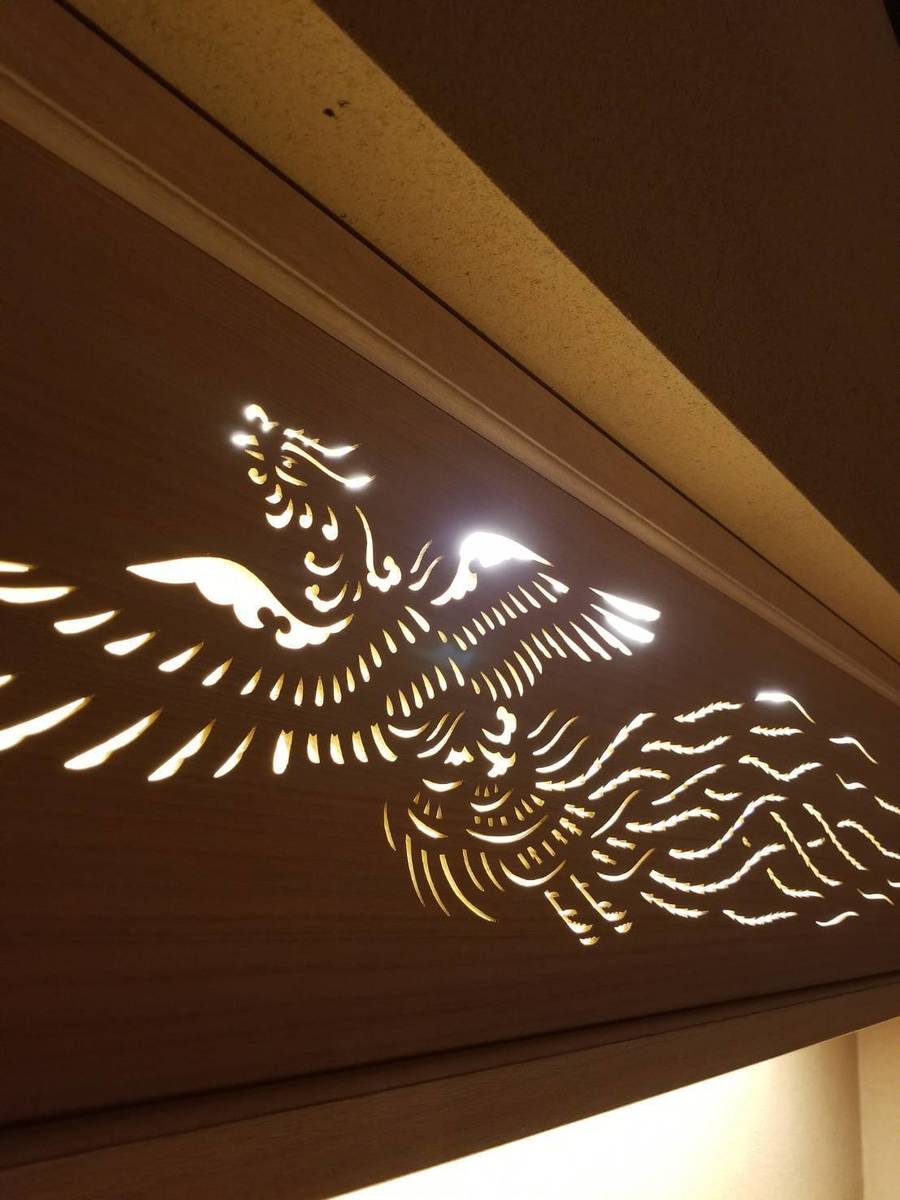ABOUT KOBE DRAGONFLY

About "Kobe Dragonfly"
In 2013, Japanese food was registered as an intangible cultural heritage by UNESCO. To be exact, it represents "Japanese food: Japanese traditional food culture", that is, the spirit of the Japanese. It is said that the true intention of UNESCO's registration of intangible cultural heritage is to promote the “culture of Japanese food” and its succession. This time, the designer who worked on the space design of “Tombo” exhibited Japanese “traditional culture, technology, and traditional arsenal” as seen from the world every time he went to Europe such as Milan and Paris. I realized the sense again, and tried and errored the means to inherit this culture and technology. On the other hand, “Tombo” shop owners also wanted to be attracted to wanting to approach their dishes as a way to show Japanese culture, and to treat people not only in Japan but around the world. Both designers and shop owners feel the space and food with their five senses (sight, hearing, smell, taste, touch). The idea of passing on the good things of Japan was realized. The place is Kobe. “TBJ Interior Design Architecture Office” will be designed and produced by total production, and the construction will be performed by “Toban Architectural Factory”, which boasts the inherited technology from the renovation of old houses. In addition, Imamura Sangyo (founded in 1684) has a history of more than 300 years, which has been engaged in wholesale trade from selling ceramics, and the traditional technique of “Osaka Kumama”, which also originated in the early 17th century and has a history of 300 years In recent years, the technique has been recognized by Starbucks and others, and the “Okamoto Meiki Store”, which has an active role, has raised its hand in the sponsorship cooperation. Tanba artist Tanbun Kiln Masafumi Onishi is one of the owners who was particular about the restaurant's food and shared his thoughts on the space that conveys the traditional culture of this Kobe Tonbo. The production was completed. “Kobe Tonbo” has become a “work” that is a collection of the passion of the company and the store owner who have a history of traditional crafts and history.
Shopkeeper / Makoto Kaori
Space design and production /
TBJ Interior Design Architecture Office http://www.tbj-design.jp
Construction / Toban Architectural Co., Ltd. http://toban.co.jp
Sponsor / Imamura Sangyo Co., Ltd. https://himeji-imamura.com
Sponsor / Okamoto Meiki Co., Ltd. https://www.okamei.co.jp
Sponsor / Tanba pottery Tanbun kiln http://tanbungama.com
Committed to Teppanyaki quality
Traditional Japanese culture “Dashi” Japanese food culture “Dashi”.
A creative teppanyaki dish that sticks to soup stock, uses a different seasonal ingredient for each month to set the theme of the base stock, and uses that stock to develop the base from appetizers to main and 〆.
Performs a cooking through the iron plate in any cuisine, including appetizers consistently, and pull out the flavor obtained through the creative iron plate cuisine.
Not to mention chemical seasonings, no salt is used in cooking, and all chef's dishes complement the taste of the ingredients.
Therefore, you can enjoy both the difficulties and effort of preparation.
The selection of drinks that match the food is also wonderful.
Providing drinks that fit non-alcoholic and alcoholic dishes.
We are particular about each dish and select beautiful tableware of Tamba, Shimizu, and Arita-yaki, and you can enjoy it even with your eyes.
The chefs are particular about the ingredients they walk around and select every time.
Committed to Interior design quality
[Facade / façade] Katagami lamp / Shop plate
Nameplate of "Kobe Tonbo" carved with pattern paper Japanese paper.
This paper pattern is a pattern for dyeing kimono and other traditional crafts from Miki Castle Town, Hyogo Prefecture since the Toyotomi Hideyoshi period.
At that time, it was delivered nationwide, mainly in Kyoto. Afraid of Harima Katagami, which was about to be cut off at the moment, Kitamura studied with Miki Katagami craftsmen by selected members of Higashihari Architectural Crafts at the Paris Design Week exhibition to see if he could inherit the tradition.
This pattern was actually carved by our staff.
Tobira
The facade is made of paulownia using a single plate. Usually, a solid board with a door of this size is too heavy, but the paulownia is a light tree that is also used for paulownia dance. The paulownia dance is also rich in fire protection and has the feature of providing a sense of security. (That's why we often hear that the kimono in the paulownia dance was protected even after the fire)
Kotobira et Key number
The small door beside it is also made of paulownia wood, with security embedded in it. Today's number is given to reserved guests, and the system can be opened by pressing the number. A production that opens the small door, and also excites the excitement of the precious guest who entered and attended.
Texture
The outer wall is made of Kyodo. (The undercoat is Jolipa, a material with 40 years of technology that is resistant to water and cracks.) A rich mix of straw susa is used to make the outer walls feel natural material texture.
ENTRANCE
When you open the door, you will see a passage reminiscent of Kyoto Koji. The stone is a beautiful 50 mm cut stone that we used for the garden. It can be seen that the craftsman manually pressed the corner. (The reason for sinking this thickness was the master's request to be able to pass through a wheelchair, and the designers were also kind and kind. The garden using this stone was beautiful on the cover of a French magazine The floor is charcoal mortar finish that is often seen in Kyoto. The space was tightened with plenty of charcoal.
Chigai -tana for Display
The shelves in the aisle are designed to resemble the shelves between the floors. Directing the image of Japan on the shelf. On the difference shelf, Japanese traditional crafts are sold and displayed as souvenirs.
CHASHITSU / Private compartment
A private room with a tea room image The semi-circle Kamoi, the walls painted in Kyotsuchi instead of the frame, and the shoji screen with the drum attached to it, with the desire to gently welcome the visitors. In the book "Praise the Shadows" by the novelist Junichiro Tanizaki, the light and red from the shoji are written as the ancient colors of Japan.
Shoji
The entrance door and the window when used create a beautiful light that is filtered from the Japanese paper drum pasted shoji.
Tatami
Japanese red tatami mats made by Kurashiki tatami-ya are adopted. Red is also the image color of Kobe dragonfly and became an art tea room.
Tokonoma & Fusuma
The floor has a lacquered finish called "Suisho". Materials we have used for more than 10 years to build modern floors. The works at the time of exhibition etc. are reflected on the floor and can be magically enchanted. Hyogo Sugihara Japanese paper is used for the storage of the red cedar floor pillars used in a full-fledged tea room, and Japanese paper of a popular writer is used for the front in an artistic manner. The air conditioner outlet also uses "Osama-ranma", and is particular about the details. A pair of phoenix lanterns are also displayed here.
It was created in the image of an artistic tea room expressing the mystery of the Orient.
Front & Bar counter
The service counter of Naguri, a vermilion-colored naguri, that jumps into the audience seats is made using a technique called "Naguri", a traditional Japanese craft, and finished with lacquer. This work was exhibited at the 2016 Paris Design Week under the name “Naguri Kitchen” and won the Grand Prize Award at the return exhibition of Milan / Paris Design Week in Kyoto that year. The theme of this year's Pari design week-Japan Design Now was "Praise for Shadows". The top plate was made of beautiful water-resistant cypress, which was made with a plane finish.It was not sold in France. It is a tied work.
Display Wall
Prepare a wall on which the artist's work can be exhibited every season. This time, the transom is decorated. It is made of a valuable material that has been sleeping in the ground for over 1000 years called Jindaisugi, and it was a product that was traded for 3,000,000 yen at that time. In the back is a powerful pine tree with a two-square ledge.
Katagami Lamp
Paper pattern Japanese paper hanging on the wall to hide the food. The Takasago pine in the foreground was the most popular at the Parry Maison Abe. All of these are original patterns of Miki stencils that have been around since Hideyoshi's era, and these small Japanese patterns were used as decoration lights.
Sukashibori Ranma
At the counter seats, you can see the transparent carved room. It is a beautiful work made by a Minister-approved traditional craftsman. Through the technique of sculpture, the illuminated light is leaked to the audience side, so that it can be used as a hand light for cooks. Since the transom was made of paulownia, the tableware on both sides is furniture made of the same paulownia wood taken from the entrance door.
Main Counter
The material of the counter is a rare material called jimatsu, and it was made with the image of a 200-year-old tree cut out of an iron plate on a single plate. Not only the top plate but also the side called the ear is finished with a plane, and it is a top plate full of craftsman's commitment.
Kozai Bari
The concrete beams that were conspicuous for the first floor of the apartment were wrapped in old wood. It seems that the old beams are used as they are, but concrete beams are wrapped in the old beams using the technique used during the restoration of old houses introduced in a French magazine this time.
Texture / interior
The whole area is finished with Kyodo, and the parts that are in direct contact are finished with natural materials to give the space a sense of calm.
Cokking counter
The kitchen-side counter seen from the audience side is finished with a single board with no knots. I imagined one large chopping board over 4m wide.
Cutting Board MANAITA
The actual cutting board uses Japanese cherry trees. With a super-plane finish, it is so glossy that there is reflection. Power of wide 1200mm.
Fujiyama Kitchen knife stand
The theme of the kitchen knives is a kitchen knives aiming at the top of the Fujiyama image. Using pine wood for the counter.
Shigarakiyaki / Sanitaryware & Counter
The washroom uses Shigaraki pottery. It is a porcelain that has its own unique shine even though it is a patented pottery. A product developed by our designers in Paris, focusing on Shigaraki soil. A gem that has won awards in Germany, including the Japanese Traditional Crafts Award. The counter is made by a craftsman of Higashi-Bari Architectural Craft.
Shikkoku Firewall -Japanese Edition
Japanese special specification born in the UK. Made by ESSE, a stove maker with a long history since 1854. It is a collaborative production between Britain and Japan that harmonizes even the oldest houses with the image of jet-black lacquer finish.
Theme-In Praise of Shadows
It is a beautiful space that is composed entirely of beautiful Japanese traditions, materials and colors with the theme of praise of shadows.

